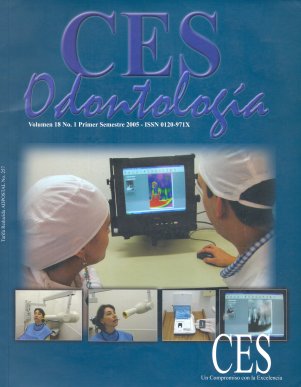La formalina como agente bactericida de microorganismos aerobios orales
Abstract
La formalina se ha utilizado como agente esterilizante, bactericida y germicida en clínicas y hospitales, sin estudios que soporten su uso o que garanticen los resultados esperados. El formaldehído, en su forma natural es un gas de bajo peso molecular, fácilmente diluible en agua y de olor irritante característico, este agente tiene gran tendencia a polimerizarse haciendo grupos de 3 y 4 moléculas obteniéndose el Trioximetanal o Para – formaldehído (formalina). Se realizó un estudio con 86 piezas de instrumental odontológico utilizado en pacientes de la Clínica CES Sabaneta, el cual luego del lavado corriente, fue expuesto a la formalina por 12 horas, luego se hizo un frotis a cada instrumento. Se incubaron las muestras 12 horas y se hicieron repicas a las 36 y 48 horas obteniendo resultados negativos para crecimiento de microorganismos en todos los casos. El grupo control estuvo compuesto por 14 instrumentos a los que se les realizó el mismo procedimiento del grupo experimental, pero sin pasar por la formalina. La formalina fue 100% efectiva como agente bactericida en microorganismos aerobios. ABSTRACT The formalin has been used as a sterilizing, bactericidal and germicide agent in clinics and hospitals, without studies that support their use or that guarantee the expected results. The formaldehyde, in its natural form is a gas of low molecular weight, easily diluible in water and of characteristic irritating scent, this agent has great tendency to cure itself doing groups of 3 and 4 molecules obtaining themselves the trioximetanal or para - formaldehyde (formalin). This study was performed with used dental instruments in patients of Clinic CES Sabaneta, after the current washing, it was exposed to formalin means by 12 hours. 86 samples of laboratory were made, after the exposition of instruments to formalin during 12 hours; frotis to each one in all its surfaces were done to them. Samples were cultivated independently with number of sample and name of instrument. Cultures were incubated during 12 hours and retorts at .36 and 48 hours were done obtaining negative results for growth of microorganisms in all the cases. Control group was composed by 14 instruments in which the same procedure of the experimental group was made, but without the use of formalin. The formalin was 100% effective used as bactericidal agent in aerobic microorganisms. Key words: formalin, bactericidal, sterilization, dental instruments.Downloads
Download data is not yet available.
Downloads
How to Cite
1.
Foronda EM, Quemba Parra JD, Conde Sánchez F, Correa Echeverri PE, Estrada Mesa S, Sanín Vásquez A, et al. La formalina como agente bactericida de microorganismos aerobios orales. CES odontol. [Internet]. 2009 Jun. 10 [cited 2024 May 18];18(1):9-13. Available from: https://revistas.ces.edu.co/index.php/odontologia/article/view/406
Issue
Section
Artículo de Investigación Científica y Tecnológica
| Article metrics | |
|---|---|
| Abstract views | |
| Galley vies | |
| PDF Views | |
| HTML views | |
| Other views | |



